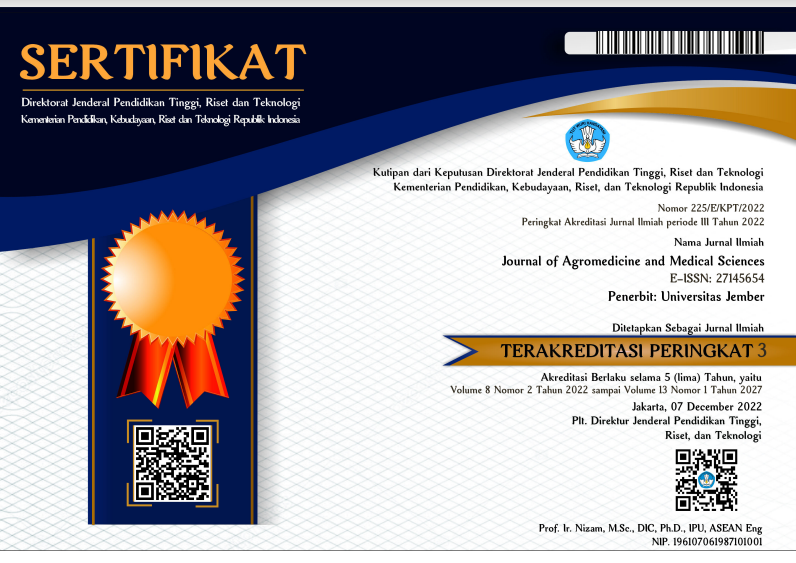Effective Dose of Moringa Leaf Extract (Moringa oleifera Lamk.) to Descrease Total Cholesterol Levels in Streptozotocin-Induced Male Wistar Rats
DOI:
https://doi.org/10.19184/ams.v8i2.27402Abstract
Lipid metabolic disorder in hyperlipidemia characterized by an increase in the entire lipid profile in the blood. In 2019, the global prevalence of hyperlipidemia was 64.2%. Many patients with diabetes mellitus developed to hyperlipidemia. Diabetes mellitus characterized by hyperglycemia that caused by insulin production defects or decreased insulin resistance. Hyperglycemia in this study resulted from the injection of a streptozotocin dose of 45mg/kgBB intraperitoneally. Hyperglycemia could induced hyperlipidemia. It is due to increased lipid synthesis resulting in overproduction of HMG-CoA and ROS. Moringa leaves contain active substances such as flavonoids and vitamin C that act as antioxidants. This study was conducted to find out the effective dose of moringa leaf extract to lower the total cholesterol levels of male Wistar rats induced by streptozotocin. The dose of moringa leaf extract was divided into 5 groups, namely 62.5 mg/kgBW, 125 mg/kgBW, 250 mg/kgBW, 500 mg/kgBW, and 1000 mg/kgBW. The analysis of the data in this study was a Pearson correlation test that showed p< 0.05. It demonstrated that administration of moringa leaf extract correlated with decreased cholesterol levels of male Wistar rats. The effective dose of moringa leaf extract was calculated using a linear regression test. The equation obtained from the regression test was y= 0.0739x + 153.59, so the dose of moringa leaf extract that effectively lowers the total cholesterol levels of male Wistar rats was 528.96 mg/kgBW.
Keywords: hyperlipidemia, diabetes mellitus, cholesterol, Moringa oleifera Lamk., streptozotocin
Downloads
References
Budiman, B., Sihombing, R. and Pradina, P. (2015) ‘Hubungan Dislipidemia, Hipertensi Dan Diabetes Melitus Dengan Kejadian Infark Miokard Akut’, Jurnal Kesehatan Masyarakat Andalas, 10(1), p. 32.
doi: http://doi.org/10.24893/jkma.v10i1.160.
Ezeh, K. J. and Ezeudemba, O. (2021) ‘Hyperlipidemia: A Review of the Novel Methods for the Management of Lipids’, Cureus, 13(7).
doi: http://doi.org/10.7759/cureus.16412.
Goud, B. J. and Swamy, Bkc. (2015) ‘Streptozotocin -A Diabetogenic Agent in Animal Models www.ijppr.humanjournals.com’, Human Journals Review Article April, 3(31), pp. 253–269.
Jain, P. G. et al. (2010) ‘Hypolipidemic activity of Moringa oleifera Lam., Moringaceae, on high fat diet induced hyperlipidemia in albino rats’, Revista Brasileira de Farmacognosia, 20(6), pp. 969–973. doi:https://doi.org/10.1590/s0102-695x2010005000038.
Janda, E. et al. (2016) ‘Molecular mechanisms of lipid- and glucose-lowering activities of bergamot flavonoids’, PharmaNutrition, 4, pp. S8–S18.
doi:http://doi.org/10.1016/j.phanu.2016.05.001.
Kholidha, A. N. et al. (2018) ‘Hubungan Kadar Kolesterol Total dan Trigliserida dengan Kejadian Diabetes Mellitus Tipe 2 di Daerah Pesisir Kota Kendari’, Medula, 5(2), pp. 448–453. doi: https://doi.org/10.36679/kedokteran.v4i2.100.
Krisnadi, A. D. (2015) Kelor Super Nutrisi, Pusat Informasi Dan Pengembangan Tanaman Kelor Indonesia. Available at: Kelorina.com.
Lin, M., Zhang, J. and Chen, X. (2018) ‘Bioactive flavonoids in Moringa oleifera and their health-promoting properties’, Journal of Functional Foods, 47(August), pp. 469–479.
doi: 10.1016/j.jff.2018.06.011.
Nada, S. et al. (2015) ‘Evaluation of Moringa Oleifera Leaves Extract Effects on Streptozotocin-Induced Diabetic Rats’, Advances in Food Sciences, 37(3), pp. 86–95. Available at: https://www.researchgate.net/ publication/280444400.
Petrie, J. R., Guzik, T. J. and Touyz, R. M. (2018) ‘Diabetes, Hypertension, and Cardiovascular Disease: Clinical Insights and Vascular Mechanisms’, Canadian Journal of Cardiology, 34(5), pp. 575–584.
doi: https://doi.org/10.1016/j.cjca.2017.12.005.
Rani, K. C. et al. (2019) Modul Pelatihan Kandungan Nutrisi Tanaman Kelor, Fakultas Farmasi Universitas Surabaya. Available at: http://repository.ubaya.ac.id/38511/.
Snipelisky, D. and Ziajka, P. (2012) ‘Diabetes and hyperlipidemia: A direct quantitative analysis—A direct analysis of the effects of insulin resistance on lipid levels in relation to atherosclerotic coronary artery disease’, World Journal of Cardiovascular Diseases, 02(01), pp. 20–25.
doi: https://doi.org/10.4236/wjcd.2012.21004.
Stohs, S. J. and Hartman, M. J. (2015) ‘Review of the safety and efficacy of Moringa oleifera’, Phytotherapy Research, 29(6), pp. 796–804.
doi: https://doi.org/10.1002/ptr.5325.
Susanty, Yudistirani, S. A. and Islam, M. B. (2019) ‘Metode Ekstraksi Untuk Perolehan Kandungan Flavanoid Tertinggi Dari Ekstrak Daun Kelor (Moringa oleifera Lam)’, Jurnal Konversi, 8(2), pp. 31–36. doi: https://doi.org/10.24853/konversi.8.2.6.
Tanuwijaya, D. C. D. (2020) ‘Efek Pemberian Ekstrak Daun Kelor (Moringa oleifera) Terhadap Kadar SGOT dan SGPT Tikus Model Diabetes Yang Diinduksi Streptozotocin’, Digital Repository Universitas Jember.
Tollo, B., Chougourou, D. C. and Todohoue, C. M. (2016) ‘Anti-Hyperglycaemic and Lipid Profile Regulatory Properties of Moringa Oleifera in Subjects At Early Stages of Type 2 Diabetes Mellitus’, Emj European Medical Journal, (October), pp. 99–105. Available at: https://www.emjreviews.com/diabetes/article/anti-hyperglycaemic-and-lipid-profile-regulatory-properties-of-moringa-oleifera-in-subjects-at-early-stages-of-type-2-diabetes-mellitus/.























